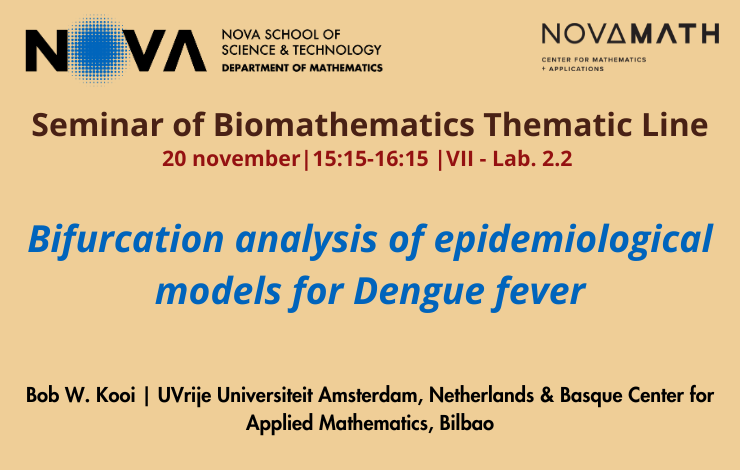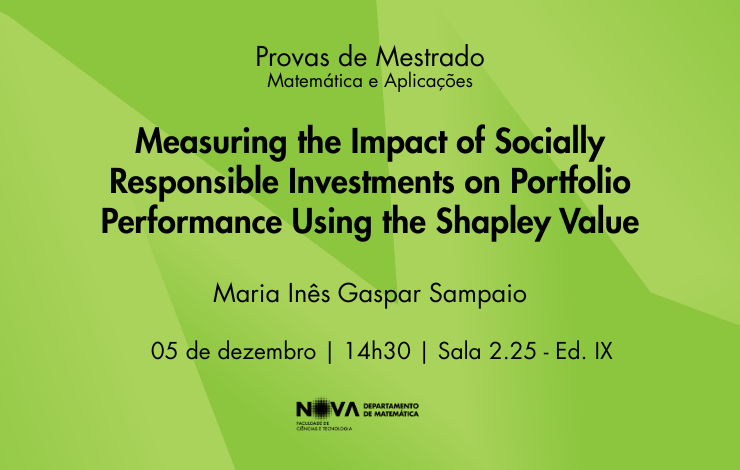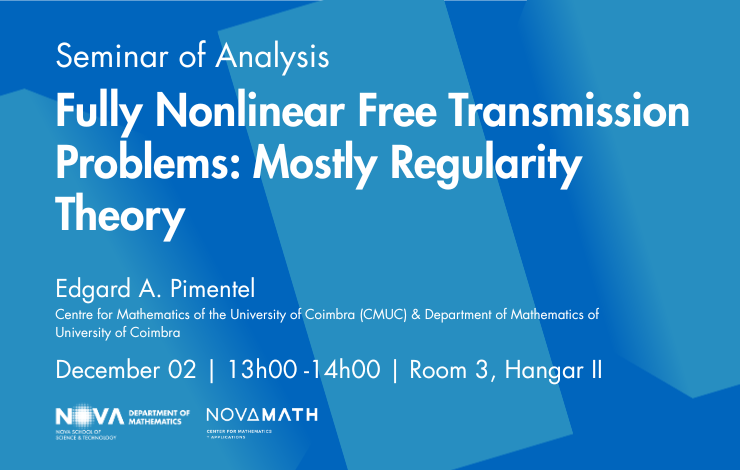The Center of Mathematics and Applications (NOVA Math), promote the Seminar of Biomathematics Thematic Line, organized jointly with the Analysis group, with the title: “Bifurcation analysis of epidemiological models for Dengue fever”. Bob W. Kooi (UVrije Universiteit Amsterdam, Netherlands & Basque Center for Applied Mathematics, Bilbao) is the speaker.
Abstract: We study the dynamic behaviour of two compartmental models for vector-borne Dengue fever disease. One is a two-strain [1] model (where a secondary infection occurs by the other strain) The other is a one-strain multi-group model (where a secondary infection is a re-infection) [2, 3]. Besides infection and recovery two epidemiological mechanisms, temporary immunity and disease enhancement or neutralization, are taken into account. The parameter values are realistic for Dengue fever epidemics [1]. Also modelling of seasonality is described. In both type of models, in addition to stable epidemiological limit cycles, quasi-periodic and chaos dynamics occurs in a wide range of parameter values. Especially the two-parametric tor infection rate versus enhancement factor in the host population will be considered. The following types of codimension-one bifurcations occur in the studied region of the parameter space: transcritical, tangent, Hopf as well a torus bifurcation for limit cycles. Further the organizing centers the cusp and Bogdanov-Takens codimension-two bifurcations and, as a consequence, also a codimension-one global bifurcation for the endemic equilibrium. In [1] it is shown that in addition a torus bifurcation destruction leads to chaos. In the autonomous version of the one-strain model, no chaos is found [4,5,6]. However, by periodical (yearly) oscillations of the number of vector individuals as forcing, chaos exists in a substantial part of the parameter space. A codimension one curve of resonance 1:1 bifurcation of the disease-free limit cycle forms also the transcritical bifurcation of the limit cycle. A torus bifurcation is the onset of a chaos. An endemic limit cycle undergoes also a tangent bifurcation, further there is a codimension-two resonance 1:1 bifurcation point which forms the boundary of the chaotic region in the parameter space as the disease-free saddle limit cycle. In conclusion: in the autonomous two-strain model a torus bifurcation gives chaos which does not exist in the one-strain model. In both non-autonomous models with periodic forcing by seasonal periodicity in the vector population, also chaos exists where the region of existence in the two-parameter diagram for the non-autonomous two-strain model is shaped by a saddle disease-free limit cycle.
References:
[1] Aguiar, M., Ballesteros, S., Kooi, B.W. Stollenwerk, N. (2011). The role of seasonality and import in a minimalistic multi-strain dengue model capturing differences between primary and secondary infections: complex dynamics and its implications for data analysis. Journal of Theoretical Biology. 289, 181-196.
[2] Rashkov, P., Venturino, E., Aguiar, M. Stollenwerk N., Kooi B.W. (2019). On the role of vector modeling in a minimalistic epidemic model. Mathematical Biosciences and Engineering, 16(5):4314–4338.
[3] Rashkov P. and Kooi B.W. (2021). Complexity of host-vector dynamics in a two strain dengue model, Journal of Biological Dynamics 15(1), 35-72.\vspace{2mm}\\
[4] Steindorf, V. Srivastav, A.K., Stollenwerk, N. Kooi B.W. and Aguiar M. (2022). Modeling secondary infections with temporary immunity and disease enhancement factor: Mechanisms for complex dynamics in simple epidemiological models, Chaos, Solitons & Fractals, 164, 112709.
[5] M Aguiar, V Steindorf, AK Srivastav, N Stollenwerk, BW Kooi, (2024), Bifurcation analysis of a two infection SIR-SIR epidemic model with temporary immunity and disease enhancement, Nonlinear Dynamics, 112, 13621–13639.
[6] V Steindorf, AK Srivastav, N Stollenwerk, BW Kooi, M Aguiar, Beyond the biting-limited impact of explicit mosquito dynamics in dengue models, BMC Infectious Diseases 24 (1), 1090.
Wednesday, 20 November 2024, from 15:15 to 16:15.




